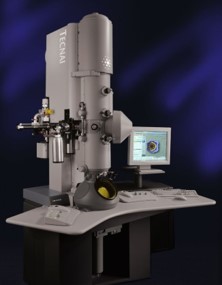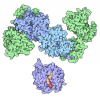[English] 日本語
 Yorodumi
Yorodumi- PDB-9dog: Octahedral small virus-like particles of dengue virus type 2 (oct... -
+ Open data
Open data
- Basic information
Basic information
| Entry | Database: PDB / ID: 9dog | ||||||
|---|---|---|---|---|---|---|---|
| Title | Octahedral small virus-like particles of dengue virus type 2 (octahedral reconstruction) | ||||||
 Components Components |
| ||||||
 Keywords Keywords | VIRUS LIKE PARTICLE / dengue virus type 2 / virus / flavivirus / virus-like particle / prM-E protein / fusion protein / cryoEM | ||||||
| Function / homology |  Function and homology information Function and homology informationflavivirin / symbiont-mediated suppression of host JAK-STAT cascade via inhibition of host TYK2 activity / host cell mitochondrion / symbiont-mediated suppression of host JAK-STAT cascade via inhibition of STAT2 activity / symbiont-mediated suppression of host cytoplasmic pattern recognition receptor signaling pathway via inhibition of MAVS activity / viral capsid / double-stranded RNA binding / nucleoside-triphosphate phosphatase / channel activity / monoatomic ion transmembrane transport ...flavivirin / symbiont-mediated suppression of host JAK-STAT cascade via inhibition of host TYK2 activity / host cell mitochondrion / symbiont-mediated suppression of host JAK-STAT cascade via inhibition of STAT2 activity / symbiont-mediated suppression of host cytoplasmic pattern recognition receptor signaling pathway via inhibition of MAVS activity / viral capsid / double-stranded RNA binding / nucleoside-triphosphate phosphatase / channel activity / monoatomic ion transmembrane transport / mRNA (guanine-N7)-methyltransferase / methyltransferase cap1 / clathrin-dependent endocytosis of virus by host cell / methyltransferase cap1 activity / mRNA 5'-cap (guanine-N7-)-methyltransferase activity / RNA helicase activity / protein dimerization activity / host cell perinuclear region of cytoplasm / host cell endoplasmic reticulum membrane / symbiont-mediated suppression of host innate immune response / RNA helicase / symbiont-mediated suppression of host type I interferon-mediated signaling pathway / symbiont-mediated activation of host autophagy / serine-type endopeptidase activity / RNA-directed RNA polymerase / viral RNA genome replication / RNA-directed RNA polymerase activity / fusion of virus membrane with host endosome membrane / viral envelope / virion attachment to host cell / host cell nucleus / virion membrane / structural molecule activity / ATP hydrolysis activity / proteolysis / extracellular region / ATP binding / metal ion binding / membrane Similarity search - Function | ||||||
| Biological species |  dengue virus type 2 dengue virus type 2 | ||||||
| Method | ELECTRON MICROSCOPY / single particle reconstruction / cryo EM / Resolution: 6.5 Å | ||||||
 Authors Authors | Johnson, A. / Dodes Traian, M. / Walsh, R.M. / Jenni, S. / Harrison, S.C. | ||||||
| Funding support |  United States, 1items United States, 1items
| ||||||
 Citation Citation |  Journal: J Virol / Year: 2025 Journal: J Virol / Year: 2025Title: Octahedral small virus-like particles of dengue virus type 2. Authors: Adam Johnson / Martín Dodes Traian / Richard M Walsh / Simon Jenni / Stephen C Harrison /  Abstract: Flavivirus envelope (E) and precursor M (prM) proteins, when ectopically expressed, assemble into empty, virus-like particles (VLPs). Cleavage of prM to M and loss of the pr fragment converts the ...Flavivirus envelope (E) and precursor M (prM) proteins, when ectopically expressed, assemble into empty, virus-like particles (VLPs). Cleavage of prM to M and loss of the pr fragment converts the VLPs from immature to mature particles, mimicking a similar maturation of authentic virions. Most of the VLPs obtained by prM-E expression are smaller than virions; early, low-resolution cryo-EM studies suggested a simple, 60-subunit, icosahedral organization. We describe here the cryo-EM structure of immature, small VLPs (smVLPs) from dengue virus type 2 and show that they have octahedral rather than icosahedral symmetry. The asymmetric unit of the octahedral particle is an asymmetric trimer of prM-E heterodimers, just as it is on icosahedral immature virions; the full, octahedrally symmetric particle thus has 24 such asymmetric trimers or 72 prM-E heterodimers in all. Cleavage of prM and release of pr generates ovoid, somewhat irregular, mature particles. Previous work has shown that mature smVLPs have fusion properties identical to those of virions, consistent with local, virion-like clustering of 36 E dimers on their surface. The cryo-EM structure and the properties of the smVLPs described here relate directly to ongoing efforts to use them as vaccine immunogens. IMPORTANCE: Ectopic expression of flavivirus envelope (E) and precursor M (prM) proteins leads to the formation and secretion of empty, virus-like particles (VLPs). We show that a major class of ...IMPORTANCE: Ectopic expression of flavivirus envelope (E) and precursor M (prM) proteins leads to the formation and secretion of empty, virus-like particles (VLPs). We show that a major class of VLPs, of smaller diameter than those of virion size ("small VLPs": smVLPs), are octahedrally symmetric particles. The known characteristics of immature virions (asymmetric trimers of prM-E heterodimers) allow us to understand the assembly of an octahedral (rather than icosahedral) surface lattice. Cleavage of prM and formation of mature, fusogenic smVLPs yield somewhat irregular, ovoid particles. These observations are directly relevant to proposals for using immunogenic but non-infectious VLPs as components of specific flavivirus vaccines. | ||||||
| History |
|
- Structure visualization
Structure visualization
| Structure viewer | Molecule:  Molmil Molmil Jmol/JSmol Jmol/JSmol |
|---|
- Downloads & links
Downloads & links
- Download
Download
| PDBx/mmCIF format |  9dog.cif.gz 9dog.cif.gz | 1.4 MB | Display |  PDBx/mmCIF format PDBx/mmCIF format |
|---|---|---|---|---|
| PDB format |  pdb9dog.ent.gz pdb9dog.ent.gz | Display |  PDB format PDB format | |
| PDBx/mmJSON format |  9dog.json.gz 9dog.json.gz | Tree view |  PDBx/mmJSON format PDBx/mmJSON format | |
| Others |  Other downloads Other downloads |
-Validation report
| Summary document |  9dog_validation.pdf.gz 9dog_validation.pdf.gz | 2 MB | Display |  wwPDB validaton report wwPDB validaton report |
|---|---|---|---|---|
| Full document |  9dog_full_validation.pdf.gz 9dog_full_validation.pdf.gz | 2 MB | Display | |
| Data in XML |  9dog_validation.xml.gz 9dog_validation.xml.gz | 494.8 KB | Display | |
| Data in CIF |  9dog_validation.cif.gz 9dog_validation.cif.gz | 771.5 KB | Display | |
| Arichive directory |  https://data.pdbj.org/pub/pdb/validation_reports/do/9dog https://data.pdbj.org/pub/pdb/validation_reports/do/9dog ftp://data.pdbj.org/pub/pdb/validation_reports/do/9dog ftp://data.pdbj.org/pub/pdb/validation_reports/do/9dog | HTTPS FTP |
-Related structure data
| Related structure data |  47083MC  9dofC M: map data used to model this data C: citing same article ( |
|---|---|
| Similar structure data | Similarity search - Function & homology  F&H Search F&H Search |
- Links
Links
- Assembly
Assembly
| Deposited unit | 
|
|---|---|
| 1 |
|
- Components
Components
| #1: Protein | Mass: 54363.801 Da / Num. of mol.: 72 Source method: isolated from a genetically manipulated source Source: (gene. exp.)  dengue virus type 2 / Cell line (production host): HEK293T / Production host: dengue virus type 2 / Cell line (production host): HEK293T / Production host:  Homo sapiens (human) / References: UniProt: G3GAJ4 Homo sapiens (human) / References: UniProt: G3GAJ4#2: Protein | Mass: 18851.695 Da / Num. of mol.: 72 Source method: isolated from a genetically manipulated source Source: (gene. exp.)  dengue virus type 2 / Cell line (production host): HEK293T / Production host: dengue virus type 2 / Cell line (production host): HEK293T / Production host:  Homo sapiens (human) / References: UniProt: P14340 Homo sapiens (human) / References: UniProt: P14340Has protein modification | N | |
|---|
-Experimental details
-Experiment
| Experiment | Method: ELECTRON MICROSCOPY |
|---|---|
| EM experiment | Aggregation state: PARTICLE / 3D reconstruction method: single particle reconstruction |
- Sample preparation
Sample preparation
| Component | Name: dengue virus type 2 / Type: VIRUS / Details: Octahedral reconstruction / Entity ID: all / Source: RECOMBINANT |
|---|---|
| Source (natural) | Organism:  dengue virus type 2 dengue virus type 2 |
| Source (recombinant) | Organism:  Homo sapiens (human) Homo sapiens (human) |
| Details of virus | Empty: YES / Enveloped: YES / Isolate: OTHER / Type: VIRUS-LIKE PARTICLE |
| Buffer solution | pH: 7.5 |
| Specimen | Embedding applied: NO / Shadowing applied: NO / Staining applied: NO / Vitrification applied: YES |
| Vitrification | Cryogen name: ETHANE |
- Electron microscopy imaging
Electron microscopy imaging
| Experimental equipment |  Model: Tecnai Polara / Image courtesy: FEI Company |
|---|---|
| Microscopy | Model: FEI POLARA 300 |
| Electron gun | Electron source:  FIELD EMISSION GUN / Accelerating voltage: 300 kV / Illumination mode: FLOOD BEAM FIELD EMISSION GUN / Accelerating voltage: 300 kV / Illumination mode: FLOOD BEAM |
| Electron lens | Mode: BRIGHT FIELD / Nominal defocus max: 3000 nm / Nominal defocus min: 1500 nm |
| Image recording | Electron dose: 42.3 e/Å2 / Film or detector model: GATAN K2 SUMMIT (4k x 4k) |
- Processing
Processing
| CTF correction | Type: PHASE FLIPPING AND AMPLITUDE CORRECTION |
|---|---|
| 3D reconstruction | Resolution: 6.5 Å / Resolution method: FSC 0.143 CUT-OFF / Num. of particles: 38934 / Symmetry type: POINT |
| Atomic model building | Protocol: RIGID BODY FIT |
| Atomic model building | Source name: AlphaFold / Type: in silico model |
 Movie
Movie Controller
Controller



 PDBj
PDBj


